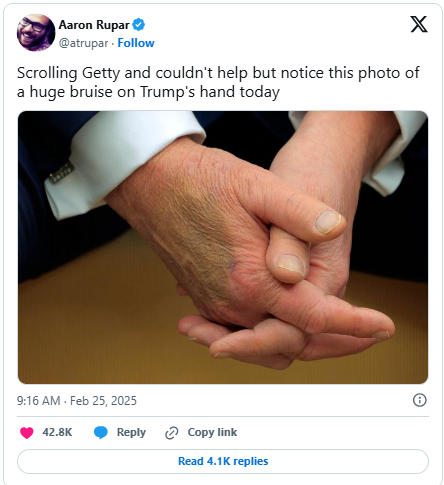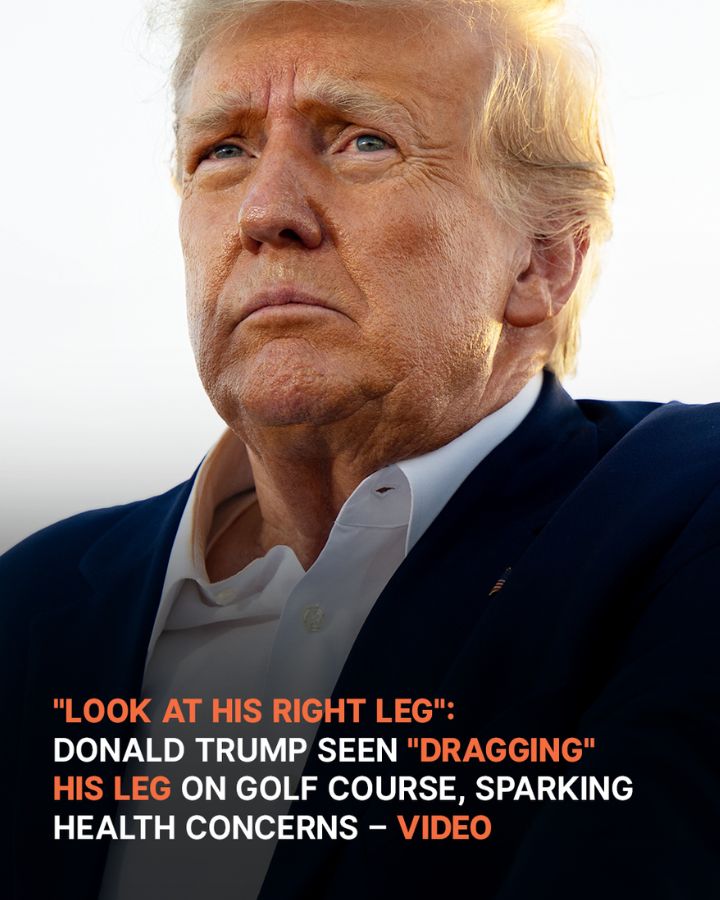
A recently circulated video of former U.S. President Donald Trump struggling to exit a golf cart has ignited widespread public speculation and concern regarding his health, specifically focusing on the condition of his legs. The footage, recorded during a casual round at Trump’s Mar-a-Lago resort in Florida, shows Trump hesitating for several seconds before managing to step out of the cart. Observers noticed what appeared to be stiffness in his legs and an unusual dragging motion, especially on the right side.
The video quickly spread across social media platforms, trending under hashtags like #TrumpHealth and #WhatsWrongWithTrump. Viewers noted how Trump, known for his vigorous public persona, seemed to exhibit difficulty coordinating his steps—a contrast to earlier footage from years prior when he was visibly more agile.
Political commentators and medical professionals alike have weighed in on the discussion. Some have suggested that Trump’s leg stiffness may simply be attributable to age-related joint or muscular issues. At 78 years old, Trump is within the age range where conditions such as arthritis, peripheral neuropathy, and general muscle stiffness are not uncommon.
However, others have proposed more concerning possibilities. One theory circulating online is that Trump may be experiencing symptoms of a neurological condition, such as Parkinson’s disease or frontotemporal dementia. These conditions can affect motor skills, resulting in slowed movements, difficulty walking, or altered gait patterns. Observers pointed out that the leg movement seen in the video resembled the “festinating gait” sometimes seen in neurological patients.

Adding fuel to the speculation, this is not the first time Trump’s physical condition has drawn public attention. Earlier this year, images surfaced showing apparent bruises on Trump’s hands during a campaign rally. At the time, Trump’s representatives dismissed the marks as minor, explaining they were likely due to frequent handshakes or accidental contact. However, some skeptics have since linked that incident with the current video, suggesting a broader pattern of unexplained physical signs.
Medical experts approached for comment caution against jumping to conclusions. Dr. Eliza Warner, a neurologist based in Washington, D.C., stated: “It’s important to remember that analyzing someone’s health from a short video clip is speculative at best. While there are visible signs of leg stiffness, these could have multiple explanations, including temporary injury or something as simple as muscle fatigue.”

Still, the public appetite for answers remains strong. Several high-profile media outlets, including major news networks, have replayed and analyzed the golf cart footage in detail. Some outlets even enlisted movement specialists and orthopedic experts to provide televised commentary on Trump’s gait, posture, and body mechanics.
In response to growing media coverage, Trump’s spokesperson, Steven Cheung, issued an official statement denying any serious health concerns. “President Trump is in excellent health for his age,” the statement read. “Reports attempting to link normal signs of aging to larger medical issues are both irresponsible and politically motivated.”

Despite official reassurances, not everyone is convinced. Some online commentators have drawn parallels between Trump’s recent appearances and incidents involving other aging political figures who eventually revealed hidden medical conditions. Comparisons were made to former President Franklin D. Roosevelt, whose use of a wheelchair was initially kept from the public.
The debate around Trump’s health also carries political ramifications. As Trump remains a key figure in the Republican Party and a potential candidate for the 2028 presidential election, questions about his fitness for office could influence public opinion and voter confidence. Political analysts have noted that health perceptions can play a critical role in campaigns, especially in tightly contested races.
A related dimension to the story is the possibility that Trump may be using a concealed leg brace or orthotic device. Some commentators highlighted the way his pants seemed to bulge slightly at the shin during the golf cart incident, leading to speculation about the use of medical support equipment such as an ankle-foot orthosis (AFO). These devices are commonly prescribed for conditions like foot drop, a neurological condition where lifting the front part of the foot is difficult.
When asked about this possibility, Trump’s physician, Dr. Sean Barbabella, provided a brief statement emphasizing that the former president’s most recent medical evaluations showed “normal musculoskeletal and neurological function.” Dr. Barbabella declined to provide further details, citing patient privacy.
Health professionals observing the controversy from the outside stress the importance of transparency. Dr. Warner noted: “Given his public status and influence, there is a strong argument to be made for clearer disclosures about Mr. Trump’s health. Voters deserve to know whether a potential leader is physically and cognitively fit for office.”
Historically, U.S. presidents have provided varying levels of medical transparency. While some, like Barack Obama, regularly released detailed annual physical reports, others, including Trump during his presidency, have been more selective about sharing medical information with the public.
For now, the public is left to interpret scattered evidence and wait for further updates. Trump is expected to undergo his next public medical evaluation within the next few months. Whether that report will address the specific concerns raised by the golf cart video remains to be seen.
In the meantime, political commentators expect Trump’s team to maintain a proactive media strategy aimed at minimizing speculation. As one former campaign adviser noted, “The optics of strength and vitality are central to Trump’s image. His team will want to control this narrative quickly and decisively.”
Whether through official reports or further public appearances, Trump’s health will likely remain under close scrutiny in the coming weeks and months. The question many are asking—“What’s wrong with Trump’s legs?”—may not have a definitive answer yet, but it has certainly become a focal point in the national conversation.